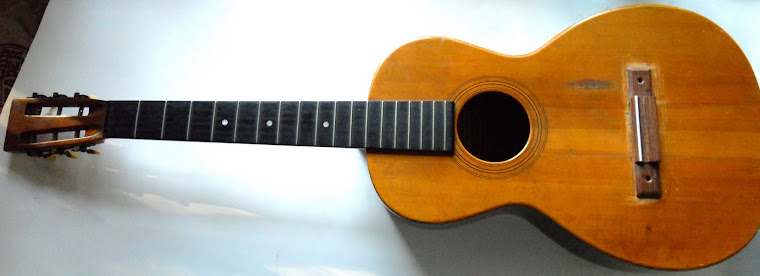So here we are in February of 2011. This is the restored Washburn. It has a lovely voice and I am delighted every time I play it as it changes.
When you first string something up, or when it hasn't been played for a long time -- like this one -- it takes almost a year for it to find its voice again. This one probably hadn't been played since 1950 or so, and it was likely made around 1890.
One of my friends who is a luthier of some 40 years experience, and whose advice I have *sometimes* taken while restoring this one, got really excited when he played it a couple weeks ago. He wants me to make a blueprint of the bracing pattern and post it with the Portland Luthier's Guild.
I first strung it up the day before Christmas. It was quieter then, and it's getting louder and richer and more resonant as the days go by.
The thing that delights me most of all, is that I listened to my intuition, and for all the conflicting expert advice I got, and all the sleepless nights where I agonized over whether to do this or that -- the thing that I am most proud of, is that I listened to myself first. I spent many hours just sitting and holding the guitar, looking at it and considering. And small things would come to me. I should not take the whole bridge plate off, just past the part that was damaged. I should cut it on the diagonal for a stronger splice.
Another thing that got me through -- taking the back off (and cracking it in the process) and shaving the braces and patching the top -- was something I learned in CPR class. It's what you say to yourself while you're attempting to revive someone, because regardless of what you do or don't do right, most of the time it doesn't work. You say: "He's already dead." So as I attempted to revive this unplayable broken 120 year old guitar, I would tell myself "It's already dead."
I didn't sleep much the night I braced and clamped the neck, and then wrapped it in an drugstore heating pad and left it on medium high for 24 hours. It could scorch the neck or the finger board, it could make it crack and split, it could set something in my studio on fire; the dangers I thought of, lying there at 3 a.m. with the covers over my head, were endless.
No one had approved this technique that I knew. I read about it in a Luthier's forum online. And the guy who came up with it was doubtful that it worked. But it did. At the end of the 24 hours I had a neck that was unbowed. And so far, it's stayed that way.
Restoring a guitar is kind of like rebuilding an engine. EVERYONE has lots of advice and opinions as to what you should do. Strong opinions. Now that it's together again, the biggest hot topic is how to string it. Never mind that I HAVE strung it and I'm quite happy to let it cook along with these strings for a good long while.
Mostly people want me to put steel strings on it. And the action. I like it. But it's high for steel string players, and the guitar, which was made for gut strings, isn't configured quite right for modern classical players -- the neck is too thin, and it's triangular, and the strings are held to the bridge with pins, not wrapped like a classical guitar. So, boy do folks have opinions. And I listen, and I learn a lot, but I don't change much on the guitar.
Oh, and another part of the creative process is that you do the things as the spirit moves you, like posting to this blog.

